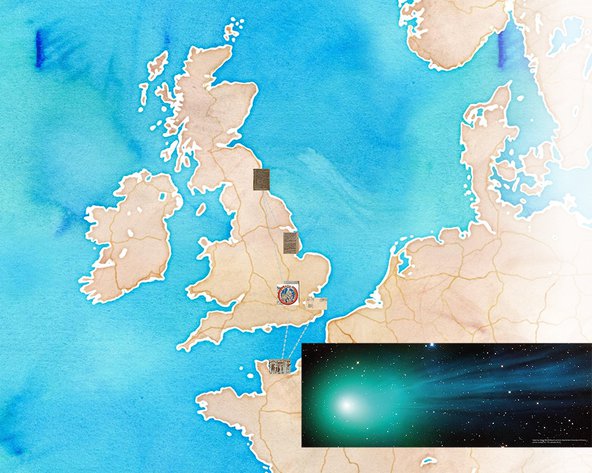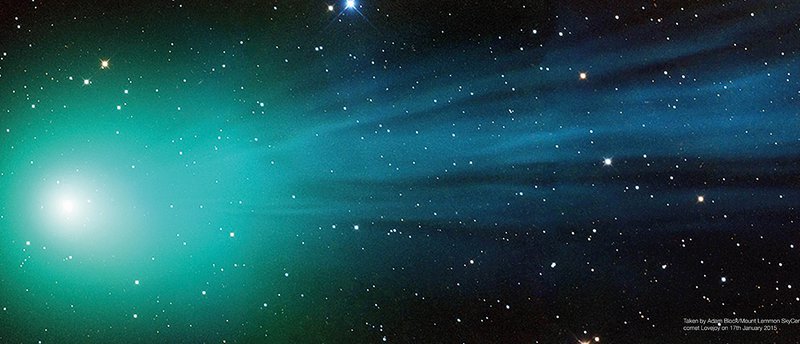Nine medieval comet sightings that signalled death and destruction
by Dr Marilina Cesario
11 Jun 2018
This blog is part of our Summer Showcase series, celebrating our free festival of ideas for curious minds.
What did Anglo-Saxons know about comets? Recordings of comet sightings are abundant in medieval chronicles, where they figure continually as portents of war, pestilence, famines, and the fall of kingdoms.
Explore some of the ways comet sightings were recorded in the medieval period on our interactive map.

In the Anglo-Saxon Chronicle, comets were noted in the following years: 678, 729, 892, 905, 975, 995, 1066, 1097, 1106, 1110 and 1114. Nine times out of 11 they were treated as bad omens: marking a death or anticipating a misfortune befalling a prominent historical figure.
1. The end of Bishop Wilfrid’s control
Saint Wilfrid of York was a powerful Northumbrian bishop in the seventh century who ruled a large number of monasteries. In year 678, a comet appeared and Bishop Wilfrid was driven from his bishopric after quarrelling with King Ecgfrith of Northumbria.
2. Death of Saint Ecgberht
Two comets were sighted in year 729 and noted in Bede’s Ecclesiastical History. Anglo-Saxon monk and nobleman, Saint Ecgberht of Ripon, died immediately after Easter Mass in the same year at age 90.
3. The failure of Æthelwold's Revolt
As a son of King Æthelred I of Wessex, Æthelwold was an eligible prince for kingship with a strong claim to the throne. He staged a rebellion in an attempt to dispute the throne with King Edward the Elder and was accepted as king in Northumbria and Essex.
The various texts of the Anglo-Saxon Chronicle tell different versions of the revolt. In some versions, it is noted that Æthelwold was killed in 902 after leading the raiding army in East Anglia into hostility at the Battle of the Holme. In other versions, Æthelwold was defeated in 905, the same year that a bright comet was sighted and recorded. The discrepancy of the years could be a case of ‘assimilated comet’, where the timing of historical events may have been manipulated in order for the natural phenomenon to be the precursor of those events.
4. Harbinger of famine and death of King Edgar the Peaceful
Edgar of Wessex became king of England in 959 and maintained peace throughout the land. In 975 a comet announced King Edgar’s death and a famine:
“Then too was seen, high in the heavens, the star on his station, that far and wide wise men call – lovers of truth and heav'nly lore – ‘cometa’ by name. Widely was spread God's vengeance then throughout the land, and famine scour'd the hills. May heaven's guardian, the glory of angels, avert these ills, and give us bliss again; that bliss to all abundance yields from earth's choice fruits, throughout this happy isle.” – The Anglo-Saxon Chronicle
5. Foreshadowing the death of Archbishop Sigic
Sigeric the Serious, also known as Sigic or Siric, was the Archbishop of Canterbury from 990 until his death. Some versions of the Anglo-Saxon Chronicle record his death in year 994 but other versions stated that in 995, a comet preceded the death of Archbishop Sigic.
6. The comet that brought the Normans
Perhaps the most well-known medieval recording of a comet sighting, Halley’s comet appears in the Bayeux Tapestry, which depicts the 1066 comet that foretold the invasion of the Normans.
7. A year of oppression and hardship
The Anglo-Saxon Chronicle recorded that, in 1097, “an uncommon star appeared shining in the evening, and soon going down: it was seen in the south-west, and the light which streamed from it seemed very long, shining towards the south-east; and it appeared after this manner nearly all the week. Many allowed that it was a comet.” This sighting was followed by an oppressive and severe year, with bad weather wreaking havoc on the harvest.
8. Lost lands and bad harvests
In June 1110, a star appeared from the “north-east and its beam stood before it towards the south-west”. Philip of Briouze, William Malet and William Bainard were participants in the Norman conquest and had helped William, Duke of Normandy to secure the crown of England. This year, they were deprived of the lands with which they had been rewarded. The Anglo-Saxon Chronicle recorded a lot of distress this year from the “taxes which the king raised for his daughter’s dowry”. The harvests also suffered due to bad weather, with crops and fruits destroyed throughout the country.
9. Abnormal natural phenomena
“An uncommon star with a long train, shining many nights” was recorded in the Anglo-Saxon Chronicle in 1114. Several strange natural phenomena occurred following this comet sighting. An ebb-tide left the Thames dry enough so that “men went riding and walking over the Thames eastward of London Bridge” and in October and November, there were exceptionally strong and violent winds that damaged woods and villages.
Dr Marilina Cesario’s research combines medieval history with astrophysics to look at how people in the past understood comets, and how this impacts our understanding of space today. Her interdisciplinary research project was funded by an APEX Award in 2017.
Medieval recordings of comet sightings, 676 – 1145
Interactive storymap




